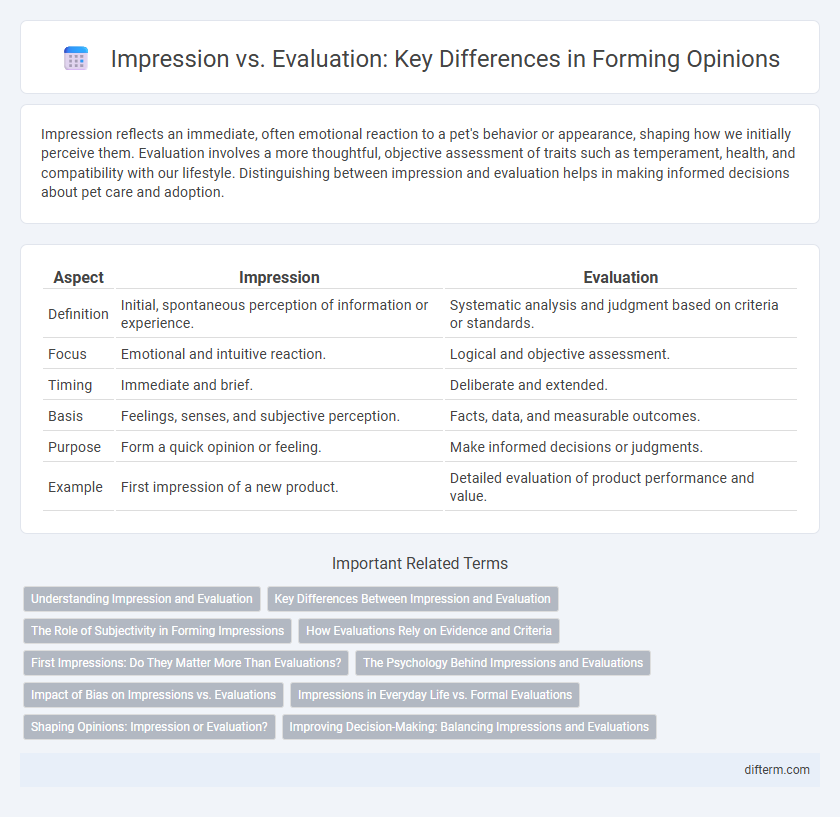Impression reflects an immediate, often emotional reaction to a pet's behavior or appearance, shaping how we initially perceive them. Evaluation involves a more thoughtful, objective assessment of traits such as temperament, health, and compatibility with our lifestyle. Distinguishing between impression and evaluation helps in making informed decisions about pet care and adoption.
Table of Comparison
| Aspect | Impression | Evaluation |
|---|---|---|
| Definition | Initial, spontaneous perception of information or experience. | Systematic analysis and judgment based on criteria or standards. |
| Focus | Emotional and intuitive reaction. | Logical and objective assessment. |
| Timing | Immediate and brief. | Deliberate and extended. |
| Basis | Feelings, senses, and subjective perception. | Facts, data, and measurable outcomes. |
| Purpose | Form a quick opinion or feeling. | Make informed decisions or judgments. |
| Example | First impression of a new product. | Detailed evaluation of product performance and value. |
Understanding Impression and Evaluation
Impression refers to the immediate, often emotional response formed upon first encountering a person, object, or situation, shaped by sensory input and subconscious cues. Evaluation involves a conscious, deliberate assessment process where information is analyzed, criteria are applied, and judgments are formed based on evidence and reasoning. Understanding the distinction between impression and evaluation is crucial for recognizing biases in decision-making and fostering more objective, informed opinions.
Key Differences Between Impression and Evaluation
Impression refers to the immediate, often subconscious perception formed about a person, object, or situation, based on limited information and feelings. Evaluation involves a more deliberate, analytical judgment that assesses qualities, performance, or value after thorough consideration. Key differences include the spontaneity of impressions versus the reasoned approach of evaluations, as well as the depth and criteria used in forming each.
The Role of Subjectivity in Forming Impressions
Subjectivity plays a crucial role in forming impressions, as individual experiences, emotions, and biases shape how people perceive others. Unlike objective evaluation, impressions are often instantaneous and influenced by personal context rather than factual analysis. This inherent subjectivity highlights the complexity of human judgment and the variability of first reactions.
How Evaluations Rely on Evidence and Criteria
Evaluations depend on clear evidence and established criteria to provide objective judgments, distinguishing them from subjective impressions that are often influenced by personal feelings. Criteria serve as benchmarks that guide evaluators in systematically assessing performance or quality, ensuring consistency and fairness. Evidence collected through accurate observation or measurement strengthens the evaluation process by grounding conclusions in verifiable facts rather than assumptions.
First Impressions: Do They Matter More Than Evaluations?
First impressions significantly shape perception by triggering immediate emotional and cognitive responses that influence subsequent evaluations. While evaluations offer a deeper, more analytical assessment, they often remain biased by the initial impression's vividness and emotional impact. Research in social psychology reveals that early impressions can disproportionately affect decision-making, highlighting their critical role in interpersonal and professional contexts.
The Psychology Behind Impressions and Evaluations
Impressions are immediate, automatic perceptions formed within milliseconds, shaped by subconscious cues like facial expressions and body language, whereas evaluations involve deliberate, conscious judgments influenced by rational analysis and context. The psychology behind these processes reveals that impressions often serve as mental shortcuts, impacting decision-making before thoughtful evaluation occurs. Understanding the distinction helps in recognizing cognitive biases and improving interpersonal assessments.
Impact of Bias on Impressions vs. Evaluations
Bias significantly shapes first impressions by triggering automatic judgments based on stereotypes or prior experiences, often leading to distorted perceptions. Evaluations, which involve more deliberate processing, can mitigate these biases but are still susceptible to confirmation bias, reinforcing initial skewed impressions. This impact underscores the importance of awareness and critical thinking in separating unbiased evaluations from biased first impressions.
Impressions in Everyday Life vs. Formal Evaluations
Impressions in everyday life are spontaneous and often shaped by limited information, relying heavily on intuition, emotions, and social cues. Formal evaluations involve systematic assessment based on defined criteria and objective evidence, aiming for accuracy and fairness. Recognizing the distinction helps balance quick judgments with thorough analysis in personal and professional contexts.
Shaping Opinions: Impression or Evaluation?
Impressions often shape initial opinions by triggering emotional and subconscious responses, embedding quick judgments based on surface-level cues such as appearance or tone. Evaluations involve a deeper, more deliberate analysis that incorporates evidence, reasoning, and critical thinking, leading to more informed and stable opinions. The balance between impression and evaluation determines whether opinions are reactive and fleeting or reflective and enduring.
Improving Decision-Making: Balancing Impressions and Evaluations
Balancing impressions and evaluations enhances decision-making by integrating immediate gut feelings with reflective analysis, leading to more accurate judgments. Prioritizing evidence-based evaluations over fleeting impressions reduces cognitive biases and improves outcome reliability. Effective decision-making relies on harmonizing intuitive responses with critical assessment to navigate complex choices successfully.
impression vs evaluation Infographic

 difterm.com
difterm.com